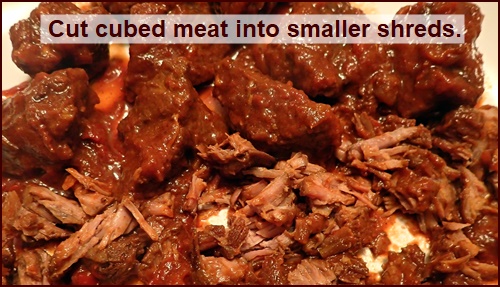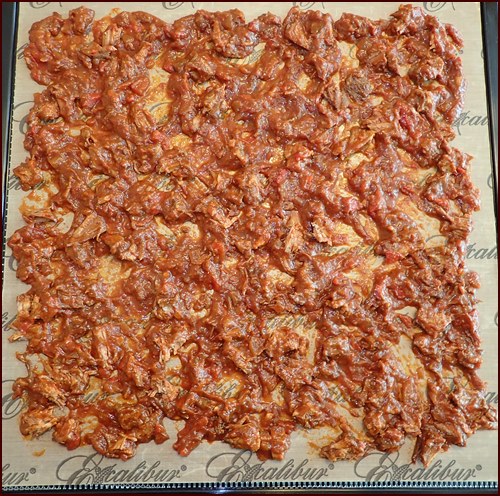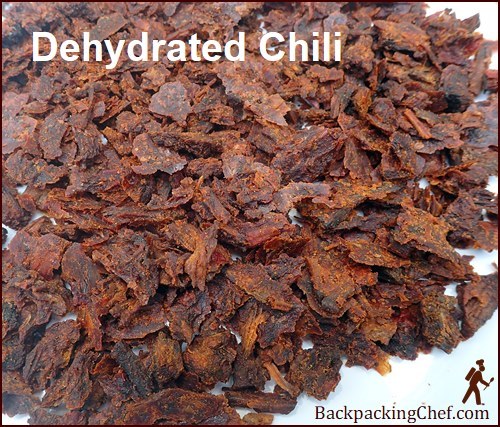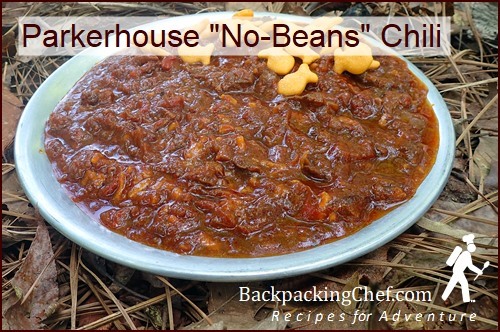| Back to Back Issues Page |
 |
|
May 2019 Trail Bytes: Can you dehydrate fatty meat? May 30, 2019 |
| Hello, This edition of Trail Bytes features the winning entry from the chili cook-off. It’s a meaty chili, so our vegetarian friends may be more interested in perusing this collection of vegetarian backpacking recipes:
25 Vegan & Vegetarian Backpacking Meals
The Chili Cook-off Winner is: Joe’s “Parkerhouse No-Beans Chili.” Joe is my youngest daughter’s husband, and he’s good in the kitchen. Since I hadn’t received any cook-off entries, I invited myself over for dinner and put in a request for chili. Joe made a huge pot of chuck roast chili, and sent me home with three cups of leftovers. The chili presented some dehydrating challenges, so we’ll cover dehydration first to highlight a few key points. Dehydrating Chunky Meat
Separate the meat chunks from the chili and cut them into smaller shreds. Return the shredded meat to the chili and mix well. Let it sit in the refrigerator for at least an hour. I refrigerated mine overnight.

Photo shows 1½ cups of chili (recommended serving size) on one Excalibur Tray. Temp: 145° F Time: approx. 14 hours Each 1½ cup portion weighed 450 grams wet and 122 grams dry. There was minimal reduction in volume from wet to dry. Beef chuck roast contains more fat than lean ground beef. I expected the chili to be dry after ten hours, but while it looked dry, it felt damp. This was the sign that there was a fair amount of fat in the chili. After fourteen hours, I determined that the chili was as dry as it was going to get. The color was getting darker.

Safe Storage Recommendation:Due to the higher than usual fat content in this chili, store it in the freezer until you are ready to leave for a backpacking trip. It will be fine out of the freezer if used within a week.The chuck roast used in this recipe was probably in the 13 – 19 percent range, although Joe removed the visible fat from the roast before he cut it into cubes. Lean ground beef, which has a fat content around seven percent, can be substituted for chuck roast in this recipe. Then you can store it longer outside of the freezer. Parkerhouse No-Bean ChiliServings: 8 – 10Cut ingredient quantities by half for a smaller yield. Ingredients:
* Ancho chile powder is made from ground, red pablano chile peppers. It adds a hint of smoke and sweetness to the chili, and just a bit more heat. Cooking Directions: Remove any hard fat, silver skin and connective tissue from the chuck roasts and cut the remaining beef into 1-inch cubes. Leave at room temperature for one hour. Coat the beef pieces with vegetable oil and 1½ tablespoons of salt. Sear the beef in batches in a large pot until well-browned on all sides. Remove the beef and set aside. Turn the heat to medium and coat the bottom of the pot in vegetable oil. Sweat the bell peppers, onions, and garlic until softened, while using a wooden spoon to lift the fond from the bottom of the pot. Add the beef and any liquids that have drained back to the pot. Season the mixture with the chili powder, cumin, paprika, and ancho chile powder. Add the tomatoes, salsa, green chiles, and beef stock. Bring the mixture to a simmer and cook, uncovered, for 2-2 ½ hours until the beef is tender, and the liquid has reduced by about half. Add the tomato paste and cook for five additional minutes. Add salt if needed.

Photo above: Rehydrated Chili. If you look close you can see a little sheen in the sauce from the fat. On the Trail:1 Serving1½ cups dried chili (122 grams) Optional: ¼ cup freeze-dried cheddar cheese (25 grams) Rehydrate with 1½ cups boiled water. Garnish with cheddar gold fish or soda crackers How was it? Meaty! The long cooking time, plus storage in the refrigerator before and after drying it, conditioned the meat so that it was tender in the rehydrated meal. The texture of the meal was more like stew, but the flavor said chili. Ancho chile powder contributed mild heat and a smoky-sweet flavor. Try Joe’s chili over rice or dehydrated hash brown potatoes. Sprechen Sie Deutsch? If you’ve been reading my newsletters for several years, you may recall that I set out to learn German a few years ago. I learned words by flipping index cards, but that was not enough to string together complete sentences, let alone have conversations with my Swiss neighbors. So, right after I finished writing The Action Guide in January, I enrolled in intensive German classes. That has fully occupied my time lately, but I’m making great progress. Going forward, I will continue learning German in semi-intensive classes. That will free up time to work on a project that we’re very excited about, Recipes for Adventure II. The new cookbook will include all new backpacking recipes. It’s too soon to say, “Coming Soon,” but we’ll keep you posted on the progress. In the meantime, we’d love to hear from you. What backpacking food topics are you keenly interested in learning more about? Freundliche Grüsse,
Chef Glenn & Dominique P.S. If you have any questions or comments about this issue of Trail Bytes, please reply to this email or use this contact form. Joe's Parkerhouse Chili is not included in Recipes for Adventure II: The Best of Trail Bytes, but you will find instructions and recipes for shrimp, seasoned ground beef, ground chicken and turkey, Canadian bacon bits, and more. 

If you received this newsletter from a friend and would like to subscribe (it's free), subscribe here. Visit my BackpackingChef Facebook page for the lastest posts. Be sure to "follow" the page to continue seeing posts. |
| Back to Back Issues Page |